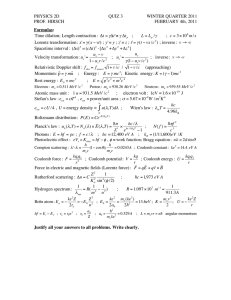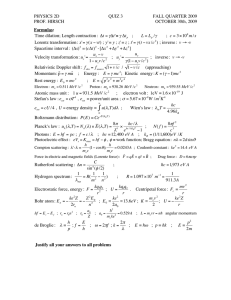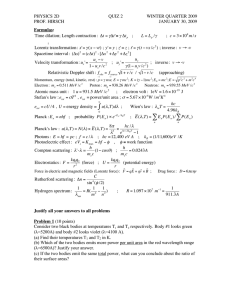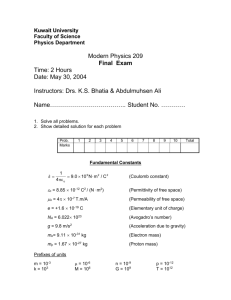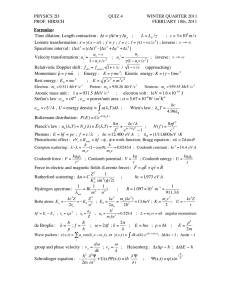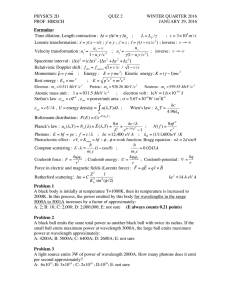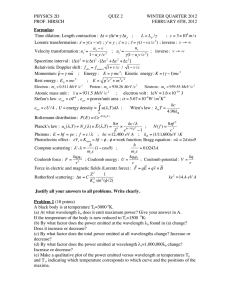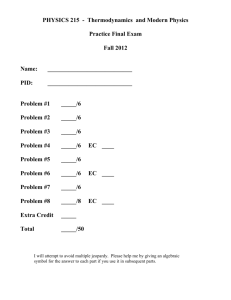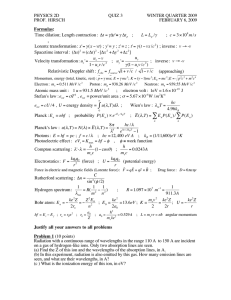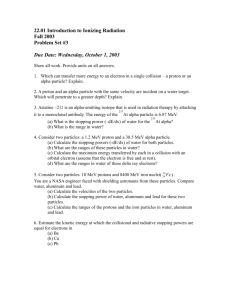PHYSICS 2D QUIZ 3 WINTER QUARTER 2012 PROF. HIRSCH
advertisement
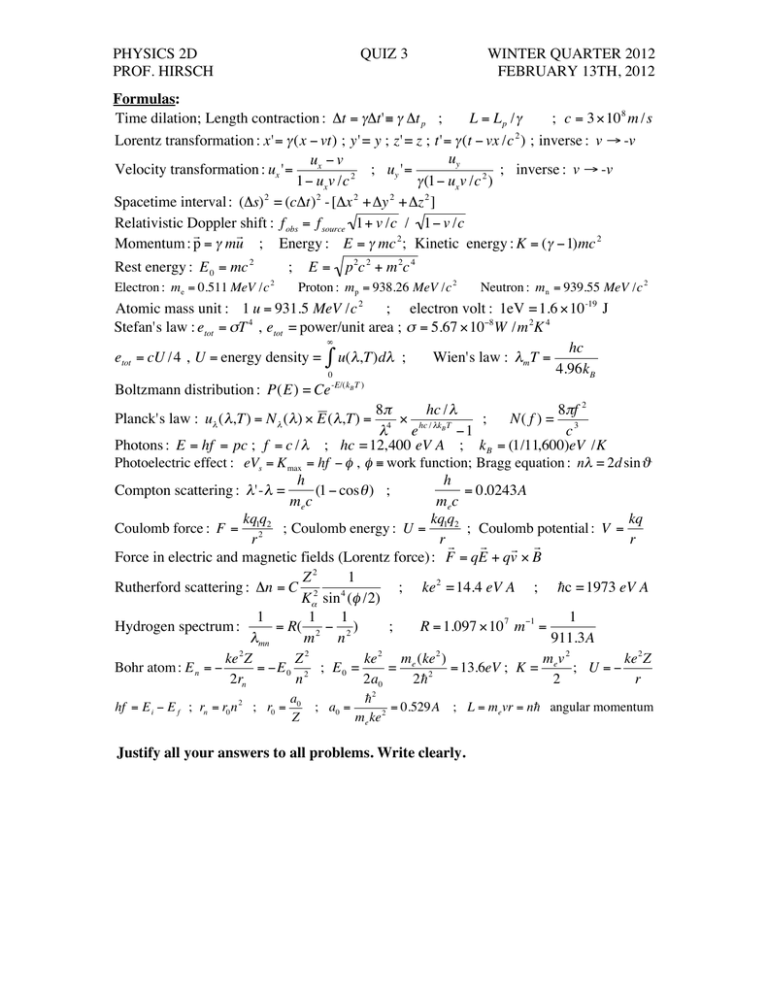
PHYSICS 2D PROF. HIRSCH ! ! ! ! ! ! ! ! ! ! ! ! ! ! ! ! ! ! ! ! ! ! QUIZ 3 WINTER QUARTER 2012 FEBRUARY 13TH, 2012 Formulas: Time dilation; Length contraction : "t = #"t'$ # "t p ; L = Lp /# ; c = 3 %10 8 m /s Lorentz transformation : x'= " (x # vt) ; y' = y ; z' = z ; t'= " (t # vx /c 2 ) ; inverse : v $ -v uy ux " v Velocity transformation : ux '= ; uy '= ; inverse : v $ -v 2 1" ux v /c # (1" ux v /c 2 ) Spacetime interval : ("s) 2 = (c"t) 2 - ["x 2 + "y 2 + "z 2 ] Relativistic Doppler shift : f obs = f source 1+ v /c / 1" v /c r r Momentum : p = " mu ; Energy : E = " mc 2 ; Kinetic energy : K = (" #1)mc 2 Rest energy : E 0 = mc 2 Electron : me = 0.511 MeV /c 2 ; E= p 2c 2 + m 2c 4 Proton : mp = 938.26 MeV /c 2 Neutron : mn = 939.55 MeV /c 2 Atomic mass unit : 1 u = 931.5 MeV /c 2 ; electron volt : 1eV = 1.6 "10 -19 J 4 Stefan's law : etot = "T , etot = power/unit area ; " = 5.67 #10$8 W /m 2K 4 # hc etot = cU /4 , U = energy density = $ u( ",T)d" ; Wien's law : "m T = 4.96kB 0 -E/(kB T ) Boltzmann distribution : P(E) = Ce 8$ hc / " 8$f 2 Planck's law : u" ( ",T) = N " ( ") # E ( ",T) = 4 # hc / "kB T ; N( f ) = 3 " e %1 c Photons : E = hf = pc ; f = c / " ; hc = 12,400 eV A ; k B = (1/11,600)eV /K Photoelectric effect : eVs = K max = hf " # , # $ work function; Bragg equation : n% = 2d sin & h h Compton scattering : "'- " = (1 # cos $ ) ; = 0.0243A mec mec kq q kq q kq Coulomb force : F = 12 2 ; Coulomb energy : U = 1 2 ; Coulomb potential : V = r rr r r r r Force in electric and magnetic fields (Lorentz force) : F = qE + qv " B Z2 1 Rutherford scattering : "n = C 2 ; ke 2 = 14.4 eV A ; hc = 1973 eV A 4 K# sin ($ /2) 1 1 1 1 Hydrogen spectrum : = R( 2 # 2 ) ; R = 1.097 $10 7 m#1 = "mn m n 911.3A 2 2 2 2 ke Z Z ke me (ke ) mev 2 ke 2 Z Bohr atom : E n = " = "E 0 2 ; E 0 = = = 13.6eV ; K = ; U =" 2rn n 2a0 2h 2 2 r hf = E i " E f ; rn = r0 n 2 ; r0 = a0 Z ; a0 = h2 = 0.529A ; L = me vr = nh angular momentum me ke 2 Justify all your answers to all problems. Write clearly. PHYSICS 2D PROF. HIRSCH QUIZ 3 WINTER QUARTER 2012 FEBRUARY 13TH, 2012 Problem 1 (10 points) In a scattering experiment with α-particles incident on a silver (Ag) foil (Z=49), it is found that for every 600 particles scattered at 900 there are 100 particles scattered at 1800 when the energy of the α-particles is 19 MeV. Instead, when the energy of the αparticles is 18 MeV, for every 600 particles scattered at 900 there are 150 particles scattered at 1800. (a) For α-particle energy 17 MeV, how many α-particles would be scattered at 1800 for every 600 particles scattered at 900? Justify your answer. (b) How many α-particles are scattered at 450 for every 600 particles scattered at 900 for α-particle energy 18 MeV? (c) What can you deduce about the size of the Ag nucleus from these data? Problem 2 (10 points) Radiation with wavelengths in the range 240A to 5000A is incident on a gas of hydrogenlike ions with atomic number Z at room temperature. The largest wavelength that is absorbed is 303.8A. (a) Find the value of Z for these ions. (b) Find all other wavelengths that are absorbed for incident radiation in this wavelength range by this gas. Explain why there are no more absorption lines. (c) After the ions absorb radiation they will emit it. State the total number of emission lines for this situation, which quantum numbers they involve, and find all their wavelengths (in A). Problem 3 (10 points) An electron in a hydrogen-like ion is in a state with kinetic energy 21.25 eV and angular momentum 4h . (a) Find the value of Z for this ion. (b) Find the speed of this electron, expressed as v/c. (c) Find the radius of the orbit of this electron, in A. ! (d) If the nucleus of this ion (with the same Z) had positrons instead of protons (mass of the positron = me) and no neutral particles, what would the total energy of the system in this state? Give your answer in eV. Hint: For electrons in hydrogen-like ions, K=-U/2 relates kinetic and potential energies. Justify all your answers to all problems. Write clearly.
